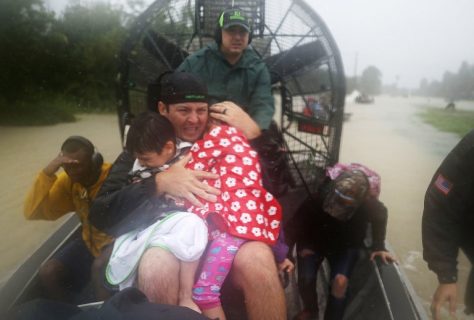
by Katie Schubauer and Jennie Matthew in Hankamer, Texas
Agence France Presse
Houston, United States (AFP) — Rescue teams in boats, trucks and helicopters scrambled Monday to reach hundreds of Texans marooned on flooded streets in and around the city of Houston before monster storm Harvey returns.
Houston mayor Sylvester Turner said more than 2,000 people had been brought, soaking and desperate to rapidly-filling shelters in America’s fourth largest city — and more are yet to come.
The 911 emergency services line has received well over 50,000 calls, but city officials urged residents facing life-threatening storm water floods to remain on the line and trust that help will come.
“The goal is rescue, that’s the major focus of the day,” Turner said, flanked by grim-faced city officials at a televised press conference, warning that 185 “critical rescue missions” are still pending and many more are expected.
“People are needing clothing. Literally, people are coming in and they are coming in wet,” he said. “We have kids, babies, up to senior citizens. They are needing everything. They are needing clothing, food, medical supplies.”
Houston fire chief Samuel Pena urged patience, promising: “We fully recognize there are many other people out there in distress situations and we intend to get to every one of them.”
Coast Guard commander Vice Admiral Karl Shultz told CNN that he had 18 helicopters in Houston, and weather permitting about 12 in the air at any one time, alongside those of the National Guard.
“If you can get to your roof, wave a towel. Leave a marking on the roof so helicopter crews can see you,” he said, describing the volume of emergency calls as “staggering.”
Dams opened
Harvey hit Texas on Friday as a Category Four hurricane, tearing down homes and businesses on the Gulf Coast before dumping what meteorologists said was an “unprecedented” nine trillion gallons of rainfall inland.
The Texas bayou and coastal prairie rapidly flooded, but the region’s sprawling cities — where drainage is slower — were worst hit, with highways swamped and street after street of housing rapidly rendered uninhabitable, power lines cut and dams overflowing.
The US Army Corps of Engineers on Monday moved to progressively open the Addicks and Barker dams — under pressure from what the agency has dubbed a “thousand-year flood event” — to prevent a catastrophe on the outskirts of Houston.
One woman, Leidys Shull, who survived the 2005 Hurricane Katrina flooding in New Orleans and moved to Houston only to be hit again, called CNN to say she was trapped with four young children.
She called 911 on Sunday and was promised evacuation, but a day later she remained stranded.
“I’ve got a big white sheet hanging up with ‘help’ written on it… some of the people saw us, but they are still not doing everything,” she said.
“The water is deep. We can’t even swim,” she said. “We said we have four itty-bitty ones under the age of six. The water is three quarters up to the top of the garage door.”
At least three people have been confirmed dead so far, but that toll is expected to rise, and the disaster is far from over: Harvey has turned back on itself and is hovering on the Gulf Coast, sucking up more rain and threatening a new landfall on Wednesday.
And, after the storm, will come clean-up and recovery.
“We actually anticipate that as many as a half-a-million people in Texas will be eligible for and applying for financial disaster assistance,” Vice President Mike Pence told KHOU Radio in Houston.
“We know it’s far from over. We know there’s more rain coming. The flood waters will likely continue to rise,” he warned.
Texas is braced for a renewed battering and President Donald Trump — facing the first major natural disaster of his presidency — declared a state of emergency in neighboring Louisiana.
Trump plans to go to the disaster zone on Tuesday and aides said he has been constantly in touch with federal and state officials involved in the response.
Federal Emergency Management Agency (FEMA) administrator Brock Long said finding shelter for those flooded out of their homes would be his next priority.
“This is a landmark event. We have not seen an event like this. You could not dream this forecast up. You couldn’t draw this situation up,” he warned.
Roads completely submerged
While the disaster response is now focused on the huge city of Houston, center of a fast-growing but loosely-planned urban area now home to more than six million people, many of those living in smaller communities by the coast were also driven from their homes.
Robert Frazier, 54-year-old foreman mechanic, left his home in La Porte, south of Houston, with his housewife Judy on Sunday morning and made it as far as a motel in Hankamer on the road towards Louisiana and still in Harvey’s path.
“We’re trapped,” Frazier said, speaking to AFP after he had tried to return home for some of his abandoned possessions, but finding the highway cut.
“I haven’t been through nothing like this.”
His wife Judy said she could only pray the rain would stop, after leaving home with just two sets of clothes, their medicine and their dog.
Beyond anything experienced
The National Weather Service said that between June 1 and Sunday, Houston had received 46 inches (117 centimeters) of rain — almost as much as it would expect in a year — in only three months.
“The breadth and intensity of this rainfall are beyond anything experienced before,” the NWS said, as the storm spawned tornadoes and lashed east and central Texas with torrential rains.
Boats also were being deployed, but more were needed. Harris County Judge Ed Emmett appealed to residents to use their own vessels.
While many citizens rushed to help their neighbors, some were less helpful, and Houston police chief Art Acevedo warned that his officers were on the lookout for looters.
© Agence France-Presse








